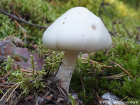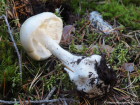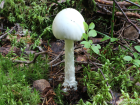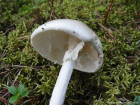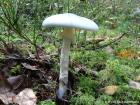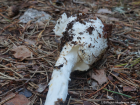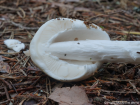Cap white to yellow in colour, at first round to egg-shaped, then flat but often retaining a flat umbo, usually with veil remnants at the margins and without any marginal striations. The flesh is white and firm. Gills white (can turn yellow), free, crowded. Stem long and thread-like and has tufts above the ring and arising from large bag-like vulva often buried deep in the soil. The large ring sits high on the stem and easily breaks and falls off. It is produced by the inner veil. Spore print white.
Microscopic Features: The spores are spherical or subglobose, with a diameter of 7-8 μm.
Note: The common name Destroying Angel is also used in North America to refer to two other fairly common Amanita species. Amanita bisporigera and Amanita ocreata are typically found in eastern and western North America, respectively.
Amanita virosa on the www.first-nature.com web site.
Many mushrooms are poisonous, and some can be lethally toxic. Distinguishing between edible and poisonous mushrooms can be very challenging. Therefore, we strongly advise against consuming wild mushrooms. This website does not contain any information about the edibility or toxicity of mushrooms.
Although efforts have been made to ensure accuracy on this website, the information may contain errors and omissions. Therefore, all content provided is for educational and informational purposes only and should not be relied upon or used as a basis for consuming any plants or mushrooms.
External links are provided for reference only. We do not endorse or take responsibility for the content, advice, or products found on these sites or in any advertisements shown on this website.
